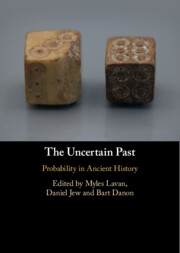Book contents
- The Uncertain Past
- The Uncertain Past
- Copyright page
- Contents
- Figures
- Tables
- Contributors
- Acknowledgements
- 1 Probabilistic Modelling in Ancient History
- Part I Uncertainty
- Part II Variability and Missing Data
- 5 Children and Their Impact on Family Finances in Roman Egypt
- 6 The Financial Sustainability of Grain Funds
- 7 New Approaches to the Urban Population and Urbanization Rate of the Roman Empire, AD 1 to 200
- 8 Afterword
- Index
- References
6 - The Financial Sustainability of Grain Funds
A Model-Based Approach Using Monte Carlo Simulation*
from Part II - Variability and Missing Data
Published online by Cambridge University Press: 18 November 2022
- The Uncertain Past
- The Uncertain Past
- Copyright page
- Contents
- Figures
- Tables
- Contributors
- Acknowledgements
- 1 Probabilistic Modelling in Ancient History
- Part I Uncertainty
- Part II Variability and Missing Data
- 5 Children and Their Impact on Family Finances in Roman Egypt
- 6 The Financial Sustainability of Grain Funds
- 7 New Approaches to the Urban Population and Urbanization Rate of the Roman Empire, AD 1 to 200
- 8 Afterword
- Index
- References
Summary
An intense debate has arisen among scholars concerning the financial sustainability of the grain funds that Greek and Roman cities used to cope with the instabilities of the grain market. In this paper, we apply a Monte Carlo simulation to model their financial dynamics. Due to the uncertainties pertaining to the scope of such funds (targeting urban dwellers only or including rural residents), our model takes into account two scenarios: ‘optimistic’ (urban only) and ‘pessimistic’ (both urban and rural). The analysis reaches several important findings: (1) For both scenarios, we witness a considerable rate of funds collapsing in their first 10 years of operation. After 10 years, however, the probability of failure displays very little change, as if there was a threshold over which the funds had accumulated enough capital to withstand shortages. (2) As expected, the survival rates are significantly higher for the optimistic scenario. (3) The withdrawals seem to have the most dramatic impact on the dynamic of the fund. Overall, while the grain funds do not appear to be sustainable in the urban-rural scenario, they show clear signs of sustainability in the urban-only scenario. The results invite reconsideration of the widespread view that grain funds were an inefficient and precarious response to food crisis.
Keywords
- Type
- Chapter
- Information
- The Uncertain PastProbability in Ancient History, pp. 231 - 270Publisher: Cambridge University PressPrint publication year: 2022



